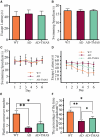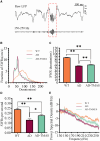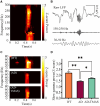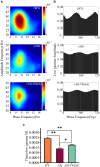Transcranial magneto-acoustic stimulation improves spatial memory and modulates hippocampal neural oscillations in a mouse model of Alzheimer's disease
- PMID: 38384480
- PMCID: PMC10879395
- DOI: 10.3389/fnins.2024.1313639
Transcranial magneto-acoustic stimulation improves spatial memory and modulates hippocampal neural oscillations in a mouse model of Alzheimer's disease
Abstract
Introduction: In our study, we applied transcranial magneto-acoustic stimulation (TMAS), a technique based on focused ultrasound stimulation within a static magnetic field, in the APP/PS1 mouse model of Alzheimer's disease (AD) to explore the feasibility of TMAS on improving AD related spatial memory deficits and abnormal neural oscillations.
Methods: The mice treated with TMAS once daily for 21 days. We recorded local field potential signals in the hippocampal CA1 region of the mice after TMAS treatment with in-vivo electrophysiology and evaluated the neural rehabilitative effect of TMAS with sharp-wave ripple (SWR), gamma oscillations during SWRs, and phase-amplitude coupling (PAC). The spatial memory function of the mice was examined by the Morris water maze (MWM) task.
Results: We found that TMAS improved the performance of MWM related spatial cognitive functions compared with AD group. Furthermore, our results implied that TMAS alleviated abnormalities in hippocampal SWRs, increased slow gamma power during SWRs, and promoted theta-slow gamma phase-amplitude coupling. These findings suggest that TMAS could have a positive influence on spatial memory through the modulation of neural oscillations.
Discussion: This work emphasizes the potential of TMAS to serve as a non-invasive method for Alzheimer's disease rehabilitation and promote the application of TMAS for the treatment of more neurological and brain aging diseases in the future.
Keywords: Alzheimer's disease; local field potentials; neural oscillations; neuromodulation; transcranial magneto-acoustic stimulation.
Copyright © 2024 Zhang, Guo, Xu, Mi, Liu, Li, Xie and Xu.
Conflict of interest statement
The authors declare that the research was conducted in the absence of any commercial or financial relationships that could be construed as a potential conflict of interest.
Figures





Similar articles
-
Effects of transcranial magneto-acoustic stimulation on cognitive function and neural signal transmission in the hippocampal CA1 region of mice.Neuroscience. 2024 Sep 25;556:86-95. doi: 10.1016/j.neuroscience.2024.01.028. Epub 2024 Jul 22. Neuroscience. 2024. PMID: 39047971
-
Transcranial magneto-acoustic stimulation enhances motor function and modulates cortical excitability of motor cortex in a Parkinson's disease mouse model.Behav Brain Res. 2025 Mar 5;480:115364. doi: 10.1016/j.bbr.2024.115364. Epub 2024 Dec 3. Behav Brain Res. 2025. PMID: 39638050
-
High-Resolution Transcranial Electrical Simulation for Living Mice Based on Magneto-Acoustic Effect.Front Neurosci. 2019 Dec 13;13:1342. doi: 10.3389/fnins.2019.01342. eCollection 2019. Front Neurosci. 2019. PMID: 31920507 Free PMC article.
-
Normal and Abnormal Sharp Wave Ripples in the Hippocampal-Entorhinal Cortex System: Implications for Memory Consolidation, Alzheimer's Disease, and Temporal Lobe Epilepsy.Front Aging Neurosci. 2021 Jun 28;13:683483. doi: 10.3389/fnagi.2021.683483. eCollection 2021. Front Aging Neurosci. 2021. PMID: 34262446 Free PMC article. Review.
-
Promoting Sleep Oscillations and Their Functional Coupling by Transcranial Stimulation Enhances Memory Consolidation in Mild Cognitive Impairment.J Neurosci. 2017 Jul 26;37(30):7111-7124. doi: 10.1523/JNEUROSCI.0260-17.2017. Epub 2017 Jun 21. J Neurosci. 2017. PMID: 28637840 Free PMC article. Review.
References
LinkOut - more resources
Full Text Sources
Miscellaneous

